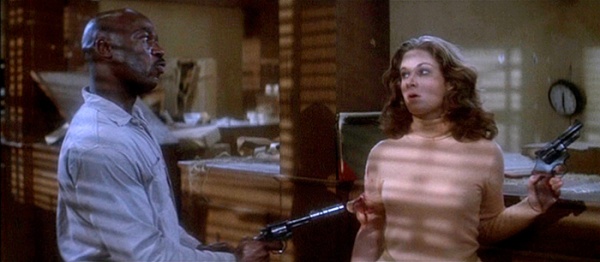|
|
| Line 1: |
Line 1: |
| | [[Image:AP13Poster DVD.jpg|thumb|right|300px|Assault on Precinct 13 (1976) - DVD cover art]] | | [[Image:AP13Poster DVD.jpg|thumb|right|300px|Assault on Precinct 13 (1976) - DVD cover art]] |
| − | ''[[Assault on Precinct 13]]'' is the 1976 thriller that was one of the earliest directorial efforts from [[John Carpenter]]. This was his first film after the cult classic '''Dark Star''' and it preceded his breakout hit ''[[Halloween (1978)|Halloween]]'' by two years. The film involves a group of police officers and citizens who are trapped in a nearly abandoned Police Precinct building in Los Angeles when a band of gang members wage murderous siege to avenge the death of their leader by a man who then sought refuge in the nearby empty building. The film bears resemblences with [[John Wayne]]'s ''[[Rio Bravo]]'', but was not a commercial nor critical success during its initial run, since American audiences didn't know what to make of it. Eventually it became a huge hit in Europe, and later a cult classic. Many view this film as a classic micro budget thriller. It was made on a shoestring budget, but still is revered by filmmakers all around the world. A big budget remake was released in [[Assault on Precinct 13 (2005)|2005]], but it was not embraced by many film fans as the original has been over the last 30 years. | + | ''Assault on Precinct 13'' is the 1976 thriller that was one of the earliest directorial efforts from [[John Carpenter]]. This was his first film after the cult classic '''Dark Star''' and it preceded his breakout hit ''[[Halloween (1978)|Halloween]]'' by two years. The film involves a group of police officers and citizens who are trapped in a nearly abandoned Police Precinct building in Los Angeles when a band of gang members wage murderous siege to avenge the death of their leader by a man who then sought refuge in the nearby empty building. The film bears resemblences with [[John Wayne]]'s ''[[Rio Bravo]]'', but was not a commercial nor critical success during its initial run, since American audiences didn't know what to make of it. Eventually it became a huge hit in Europe, and later a cult classic. Many view this film as a classic micro budget thriller. It was made on a shoestring budget, but still is revered by filmmakers all around the world. A big budget remake was released in [[Assault on Precinct 13 (2005)|2005]], but it was not embraced by many film fans as the original has been over the last 30 years. |
| | | | |
| | '''The following guns were used in the 1976 film ''Assault on Precinct 13:''' | | '''The following guns were used in the 1976 film ''Assault on Precinct 13:''' |
Revision as of 18:28, 11 June 2011
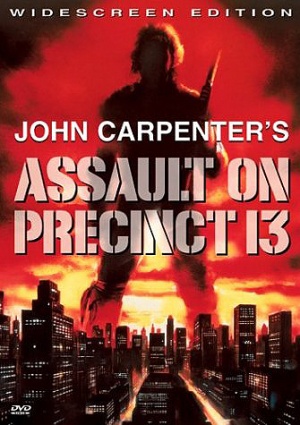
Assault on Precinct 13 (1976) - DVD cover art
Assault on Precinct 13 is the 1976 thriller that was one of the earliest directorial efforts from John Carpenter. This was his first film after the cult classic Dark Star and it preceded his breakout hit Halloween by two years. The film involves a group of police officers and citizens who are trapped in a nearly abandoned Police Precinct building in Los Angeles when a band of gang members wage murderous siege to avenge the death of their leader by a man who then sought refuge in the nearby empty building. The film bears resemblences with John Wayne's Rio Bravo, but was not a commercial nor critical success during its initial run, since American audiences didn't know what to make of it. Eventually it became a huge hit in Europe, and later a cult classic. Many view this film as a classic micro budget thriller. It was made on a shoestring budget, but still is revered by filmmakers all around the world. A big budget remake was released in 2005, but it was not embraced by many film fans as the original has been over the last 30 years.
The following guns were used in the 1976 film Assault on Precinct 13:
High Standard Model K-1200 Riot Shotguns
High Standard K-1200 Riot Standard Model Shotguns are used extensively by police and Prison guards. They are seen in the first sequence of the movie when heavily armed LAPD officers ambush six gun toting "Street Thunder" gang members, killing all of them. This massacre prompts the 'Street Thunder" gang to essentially declare war on the Police and the citizens of Los Angeles.

High Standard K-1200 Riot Standard Model - 12 gauge
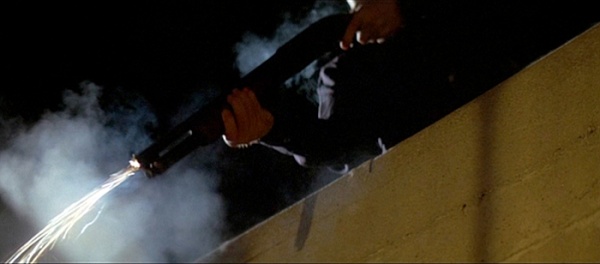
LAPD officers ambush the gangmembers with High Standard K-120 Shotguns - 12 gauge

This image may seem reversed since the officer in back is firing left handed, but the shooter closer to the camera is firing right handed
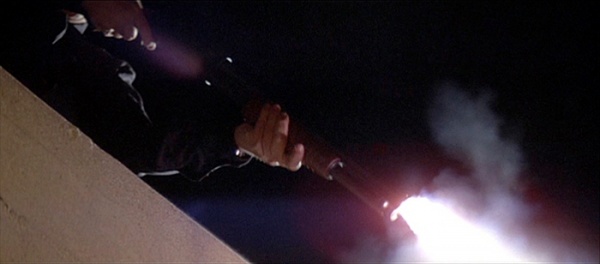
LAPD officer on the left ambushes with his High Standard K-1200 Riot Standard Model - 12 gauge.
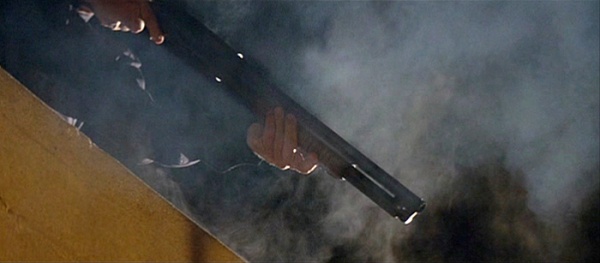
Closer look at the shotgun after the shootout.
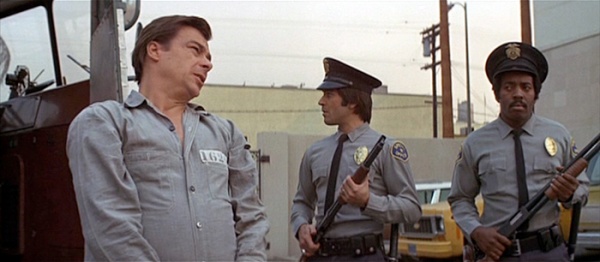
Two Prison Guards hold High Standard K-1200 Riot Standard Model Shotguns and look on while Napoleon Wilson (
Darwin Joston) talks to the Warden - 12 gauge.

When Napoleon Wilson (
Darwin Joston) trips the Warden (
John J. Fox) with his chain, the two guards hold their High Standard K-1200 Riot Standard Model Shotguns at his head - 12 gauge.
Winchester Model 1897 Shotgun
One of the last leftovers in the precinct, the Winchester Model 1897 is first seen when cynical LAPD Precinct Captain (James Jeter) pulls one of a left over wooden crate and loads it, foreshadowing that newcomer Lieutenant Ethan Bishop will probably need it before dawn. The Winchester Model 1897 is extensively used by Napoleon Wilson (Darwin Joston).

Winchester Model 1897 - 12 gauge. This is an imported copy of the non-take down version of the Winchester 1897 Shotgun (a Norinco 97W shotgun, imported by IAC).
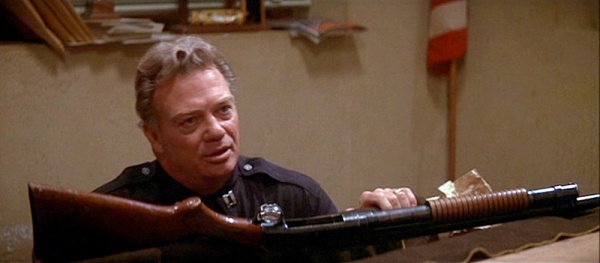
Precinct Captain (
James Jeter) picks up a vintage Winchester Model 1897 from a wooden crate, one of the last items to be shipped to the new precinct - 12 gauge
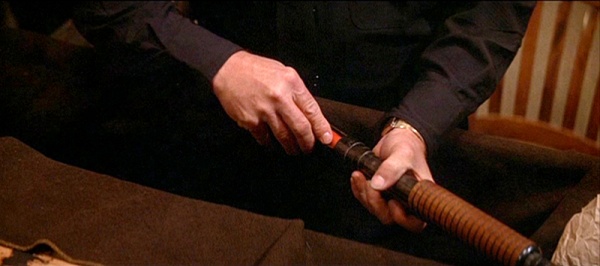
Precinct Captain (
James Jeter) loads up the Winchester Model 1897 when he talks about the crime ridden area they are in - 12 gauge
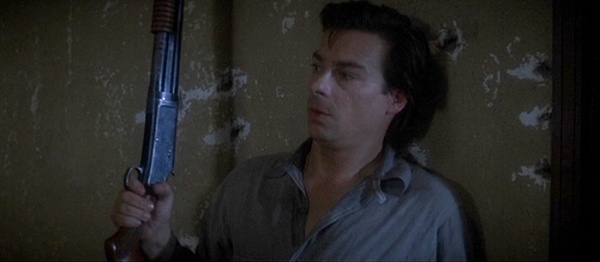
Napoleon Wilson (
Darwin Joston) uses the Winchester Model 1897 for the rest of the film - 12 gauge. Though similar to the later Model 1912, the receiver of this gun and the exposed hammer indicates that it is indeed a Model 1897.
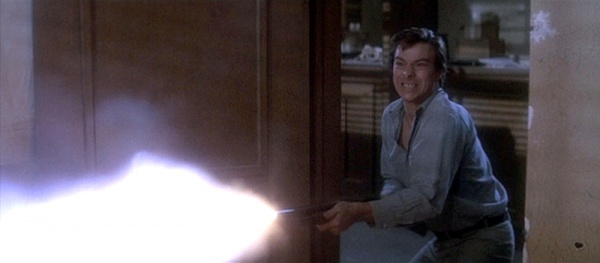
Utilizing the
slamfire feature of the Winchester Model 1897, Napoleon Wilson (
Darwin Joston) fires groups of two or three shots in rapid succession at the attackers. It is assumed that he reloads often, however, this is done off screen. In an interesting shot, the actor actually (slightly) burns his left hand because he fires so many shots in rapid succession.
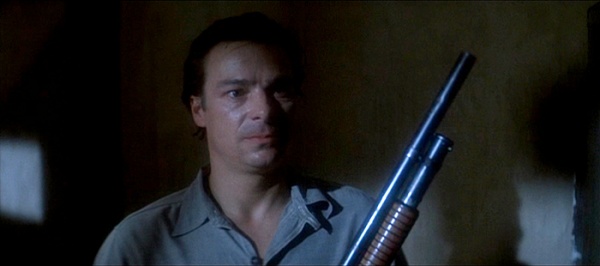
Napoleon Wilson (
Darwin Joston) awaits the final onslaught with his Winchester Model 1897 shotgun - 12 gauge.
Colt AR15-SP1
Used by the gang "Street Thunder". The civilian counterpart of the first variant M16. Colt sold this semi-automatic version of the first pattern M16 for years after the military had already upgraded to the A1 version. Only years later did Colt start selling the civilian rifle with the additional features of the M16A1. In one scene we clearly see that the rifle is an Colt AR15 Model SP1 rifle due to a nice closeup of the lower receiver.

The original M16 - the military version of the AR15 SP1 rifle - 5.56x45mm
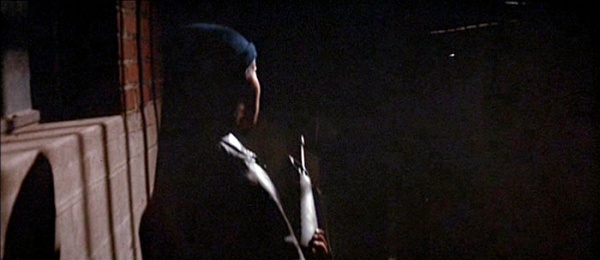
What started it all. An Asian gang member walks slowly down a dark alley with a stolen "M16". Though with a group of other gang members of various races, he and his cohorts will be gunned down by LAPD officers lying in wait with shotguns - 5.56mm
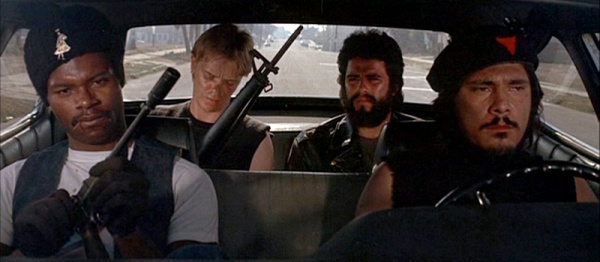
The "White Warlord" (
Frank Doubleday) of the apparently multi-racial gang "Street Thunder" can be seen in the back of a cruising car, ready to affix his 'suppressor' to his AR15 - 5.56mm. It is definitely a real AR15 SP1 rifle due to the threaded barrel end. In the front passenger seat "Black Warlord" (
James Johnson) affixes a suppressor to his C96 Broomhandle Mauser pistol.

"White Warlord" (
Frank Doubleday) cruises for a suitable target with his AR15 SP1 rifle (masquerading as a military M16 that was stolen from an armory), with a suppressor and an ART I scope - 5.56mm
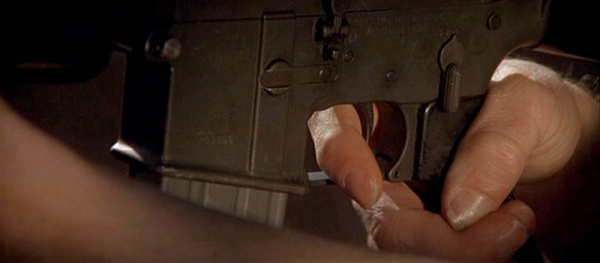
A close up of the Colt marked AR15 SP1 receiver - 5.56mm
Adler-Jager AP74 Rifle
The .22 LR clone of the M16/AR-15 rifle is seen in the gang's headquarters after the weapons theft. Normally a film of this time period would use the MGC Replica M16 rifles, however, the round 'doughnut' shape of the hand guard ring indicates that these are the Adler-Jager AP74 rifles.

Adler-Jager AP74 rifle - .22 LR

Seen leaning against the wall are Adler-Jager AP74 rifles, impersonating M16/AR15 rifles - .22 LR
Winchester Model 70
CHP Lieutenant Ethan Bishop (Austin Stoker) uses a leftover Winchester Model 70 rifle with scope during the night time siege.

Winchester Model 70 with rifle sights on the barrel - .30-06.
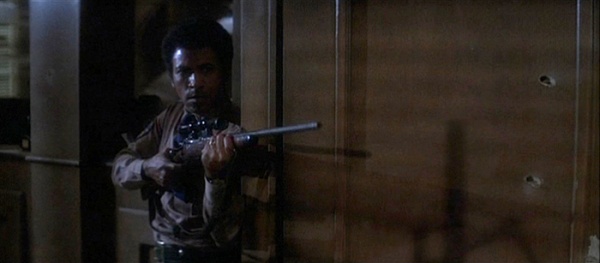
Lieutenant Ethan Bishop (
Austin Stoker) holds a Winchester Model 70 rifle during the siege - .30-06.

Bishop (
Austin Stoker) fires his Winchester Model 70 during one of the battles in the precinct - .30-06

During the final battle, Bishop (
Austin Stoker) must use one of the remaining three rounds for his Winchester Model 70 to hit an acetylene gas tank to blow up a group of attacking gang members - .30-06.
C96 Mauser Pistol
Seen originally in a crate of stolen weapons, the Mauser C96 features prominently amongst the gang members, with some of them having 'silencers' affixed on the barrels. (Note: these so called 'silencers' were would only lower the decibels a little bit, being too short and small). The C96 'Broomhandle Mauser" pistol also featured prominently in the most controversial scene of the film, the gunning down of a little girl, which prompts the entire evenings' events.
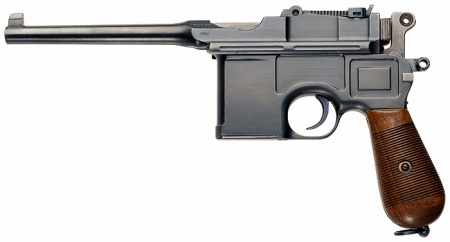
C96 Broomhandle Mauser - 7.63x25mm Mauser
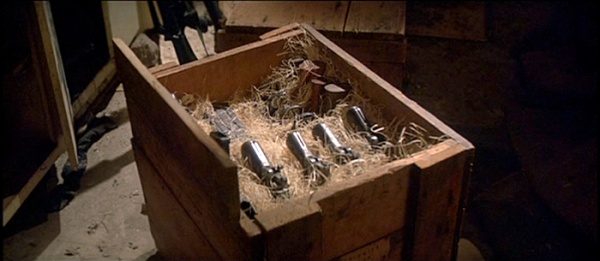
At the beginning of the film, we see the crates with the stolen weapons. Prominent among them is a crate with a group of C96 Broomhandle Mausers, identifiable by the shape of the pistol grip and the slot for the C96 Buttstock - 7.63x25mm Mauser
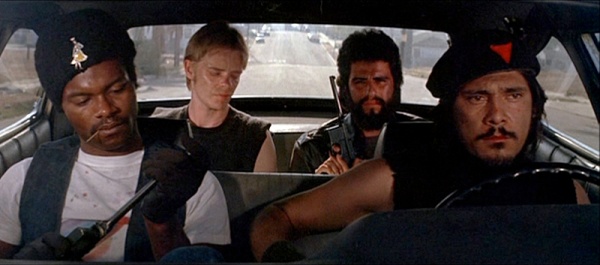
A group of warlords for Street Thunder cruise for victims. Seen are the white, black and Chicano warlords. An additional gangmember is seen in the back with a plain C96 Mauser Pistol, while the Black Warlord affixes a 'suppressor' to his C96 Mauser - 7.63x25mm Mauser
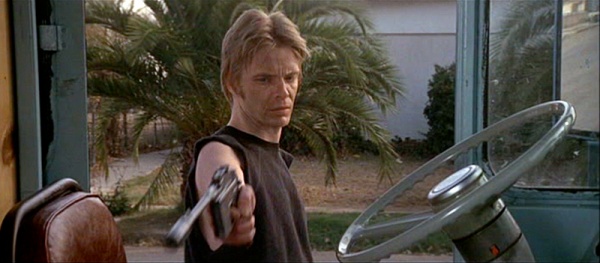
"White Warlord" (
Frank Doubleday) shoots with his suppressed C96 Mauser Pistol - - 7.63x25mm Mauser
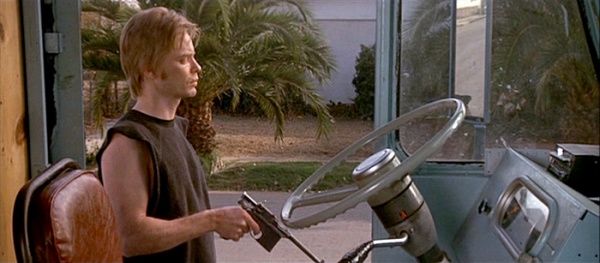
"White Warlord" (
Frank Doubleday) shoots the injured ice cream truck driver with his suppressed C96 Mauser Pistol - - 7.63x25mm Mauser. The slide locks back after only three shots, indicating that he had only three shots left in his pistol.
Smith & Wesson Model 36
A Smith & Wesson Model 36 Chiefs Special Snub is seen in a holster under the steering wheel of an Ice Cream truck. The driver has it for self protection and eventually (with his dying breath) tells Lawson (Martin West) about the gun, so that Lawson can avenge the murder of his little girl, Kathy (Kim Richards).
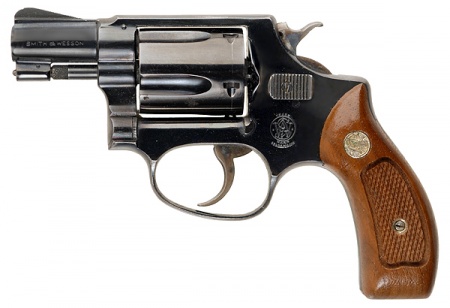
Smith and Wesson Model 36 - .38 special - 5 shot
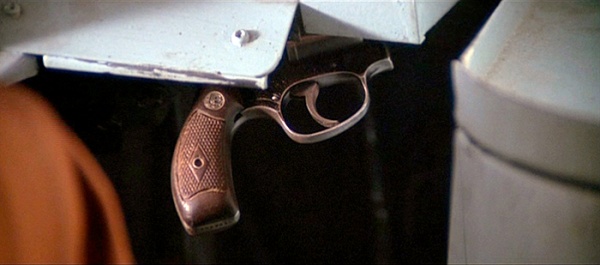
Hidden beneath the steering wheel of the Ice Cream truck is a Smith & Wesson Model 36 snub nosed revolver - .38 special. Though we can see bare metal, due to the wear and tear on the revolver, it is not a stainless steel version since we can still see the blueing on the frame.Since it has the diamond grips it probably dates back to the fifties or early sixties.S&W went away from the diamond grips in the late sixties.
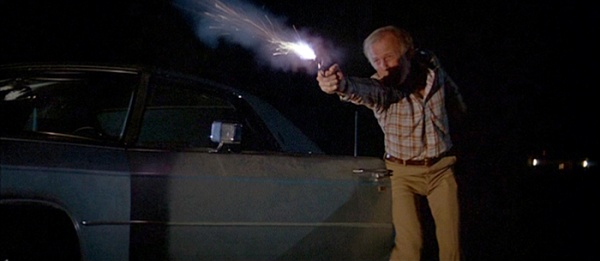
In his insane grief, Lawson (
Martin West) uses the driver's Smith & Wesson Model 36 to gun down the gang member who murdered his little girl - .38 special
Colt Trooper
LAPD Sergeant Chaney (Henry Brandon) carries what appears to be a Colt Trooper , though it is hard to determine. The Medallion on the grip (upon several viewings) appears to be the silver Colt Horse, and not the brass S&W medallion) as well as the style of the grip. One of the ill fated Prison Guards at the beginning of the film also carries one.

Colt Trooper - .357 magnum

Sgt. Chaney (
Henry Brandon) helps Leigh with the stricken Lawson, when he stumbles into the precinct. Chaney has a Colt Trooper in his holster - .357 magnum.
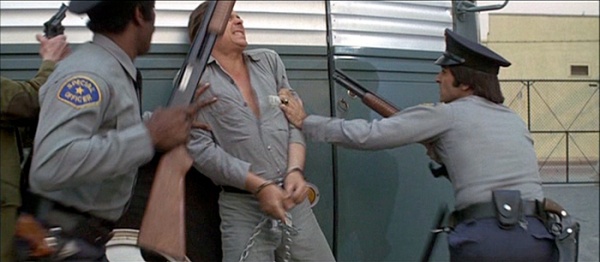
One of the ill fated Prison guards has a Colt Trooper in his holster as well (man on right), however the Guard on the left has a Smith & Wesson Model 10 in his holster - .357 magnum.
Smith & Wesson M&P Revolver
A Street Thunder gang member enters with a 'silenced' revolver, though in real life a suppressor would not work on a revolver. He is knocked down and the gun is taken by convict Wells (Tony Burton) and used throughout the rest of the film. The revolver is a Smith & Wesson M&P (the precursor to the Model 10) with it's front sights removed and barrel tip threaded to take the small suppressor.
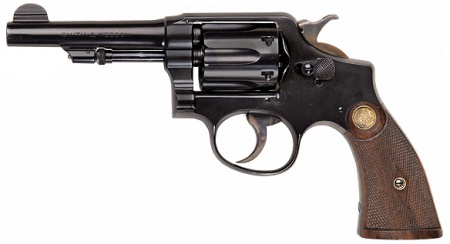
Smith & Wesson Model M&P Revolver - .38 Special

A Street Thunder gang member enters the rear of the building with his suppressed Smith & Wesson M&P Revolver - .38 special
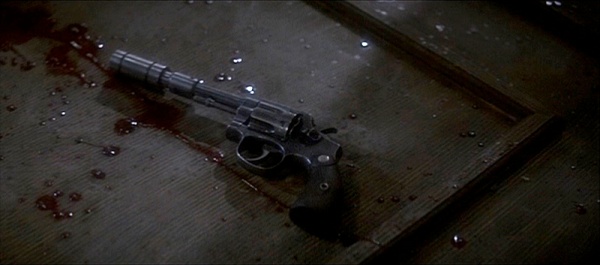
The suppressed Smith & Wesson M&P Revolver after it falls on the floor - .38 special. Wells (
Tony Burton picks it up and uses it during the assault.
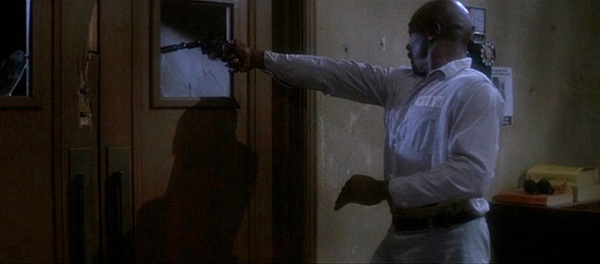
Wells (
Tony Burton uses the suppressed Smith & Wesson M&P Revolver during the attack - .38 special

When Leigh convinces Wells (
Tony Burton) to not shoot her, he discovers that his gun is empty and has been empty throughout the latter half of the battle - .38 special.
Smith & Wesson Model 28
CHP Lieutenant Ethan Bishop (Austin Stoker) uses a 4" barreled Smith & Wesson Model 28 Highway Patrolman , which he carries as part of his duty belt. The revolver is later used by Leigh (Laurie Zimmer) for the rest of the film. Having been shot in her right arm, Leigh must fire the Model 28, in the final battles, with her left hand, even though she is right handed. At the beginning of the film, Starker (Charles Cyphers) also carries one before he is killed. Smith & Wesson did not start manufacturing the Model 27 with the four inch barrel until 1979. Before then the shortest length the Model 27 had was 3.5". It's very distinctive looking from the 4" barrel. Since the movie was filmed in 1976 it would have to be the Model 28.

S&W Model 28 Highway Patrolman with 4" bl.
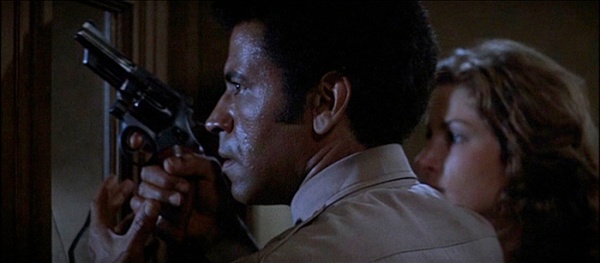
Bishop (
Austin Stoker) holds his Smith & Wesson Model 28 revolver close as he looks out the window, with Leigh close behind - .357 magnum. His revolver is outfitted with the old style target grips. They have no cut-out for speed loaders.
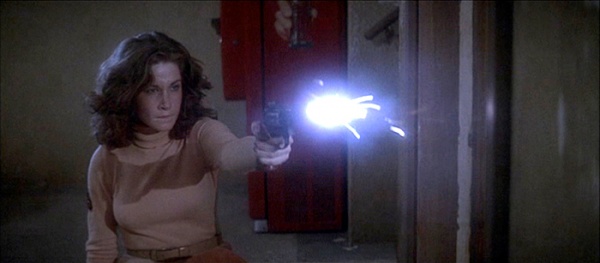
Leigh (
Laurie Zimmer) has to use her left hand to shoot at gang members trying to break in the back entrance - .357 magnum.
Smith & Wesson Model 15
Brief glimpses of Smith & Wesson Model 15 revolvers are seen. One is carried by the LAPD Precinct Captain (James Jeter) in his holster, but it is never pulled. The Smith & Wesson Model 15 was the standard issue revolver for all L.A.P.D. officers in the seventies. Carried by one of the ill fated Prison Guards, and by the Motorcycle officers at the end of the film.
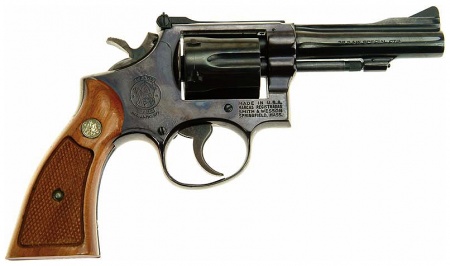
Smith & Wesson Model 15 Revolver - .38 Special
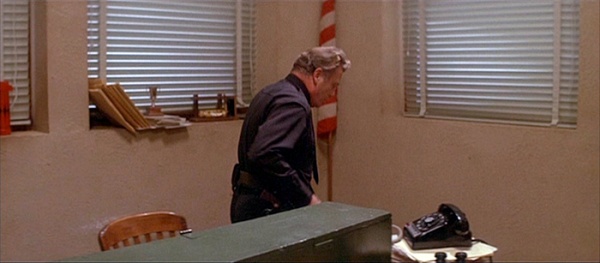
Seen briefly, LAPD Precinct Captain (
James Jeter) has a S&W Model 15 in his holster - .38 special. Note: This is an educated guess since it is never drawn, however, multiple viewings seem to reveal the gold S&W Medallion on the grip, so the Model 15 is a good bet.

The LAPD Precinct Captain (
James Jeter) prepares to leave the station to Lt. Bishop, his S&W Model 15 holstered - .38 special

Seen briefly, one of the LAPD motorcycle cops has a S&W Model 15 when he enters the smoke filled precinct - .38 special
Notes
Controversial "Ice Cream Scene"
- When the film was first released, the MPAA at first threatened to brand the film with an "X" for violence if they did not remove the scene where "White Warlord" (Frank Doubleday) callously shoots the little girl, Kathy (Kim Richards), when she goes back for a different flavor of ice cream. This cold blooded shooting still manages to shock viewers today, however not as much as it did back in 1976.

"White Warlord" (
Frank Doubleday) shoots Kathy with nary a word, with his suppressed C96 Mauser Pistol - - 7.63x25mm Mauser. This scene shocked audiences in its day and still manages to shock viewers today due to its inhumane and cold blooded nature.

Kathy (Kim Richards) reacts to getting shot in the chest when she merely asks for a different flavor of ice cream, in one of the most controversial cinema scenes of its day.
Trivia: CHP Uniform
- The California Highway Patrol has long maintained that filmmakers must get official approval before showing any actor or character as a member of the CHP. Thus any film that portrays the CHP, must use different insignia and badge emblems, in order to not violate the CHP's copyright of their image. Lieutenant Ethan Bishop (Austin Stoker) wears a generic uniform, that has patches that merely say "Highway Patrol" with no reference to the state of California (also the patches are about four inches too low on his sleeves). His badge is a plain gold badge with no markings whatsoever, again done to appease the CHP. (Trivia note: the television series "CHiPs" was done with the full cooperation and approval of the California Highway Patrol, and even then their uniforms had to be slightly different than the real thing, due to the strict rules of the agency).
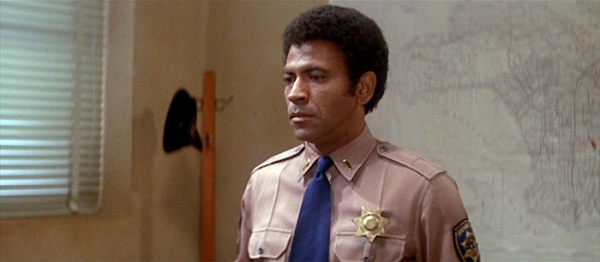
Lieutenant Ethan Bishop (
Austin Stoker) wears an unusual "CHP" uniform.
Movie Posters
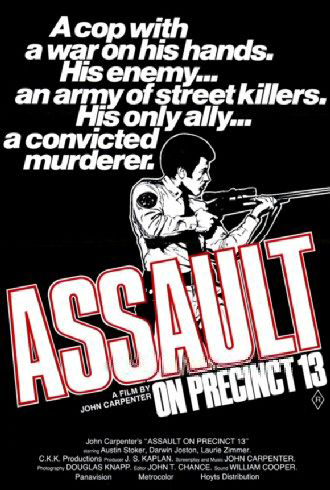
A vintage movie poster for the film - this one was a common one in the United State during the time of the film's release. Many movie posters of the time still incorporated artwork versus photography in their design.
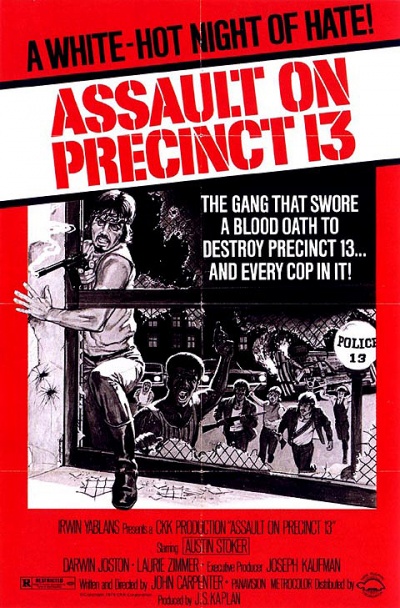
A vintage movie poster for the film - this one is much grittier and evokes a
grindhouse' feel. The pulp nature of the artwork is indicative of the time period.



















